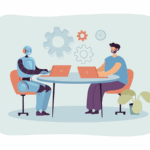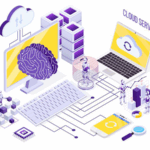Dominate 2025 with Next-Gen AI and ML Services for Future-Ready Growth
August 7, 2025 | 0 Comments
info@trickywebsolutions.com |
+1-225-276-2741
 USA
USA IN
IN
 SG
SG
 PT
PT
In the fast-changing software development landscape, where the technology changes in popularity in a very short timeframe, one stack still remains as popular as before. We are talking not other than but the MERN stack technology, which is just gaining more popularity day by day. Being the combination of MongoDB, Express.js, React.js, and Node.js, this technology is widely known for building scalable MERN stack applications. When it comes to building modern applications, user experience, along with performance, matters the most. Slow and unresponsive sites can be frustrating and drive users to alternative options. Therefore, it is essential to build MERN stack applications that are optimized and can handle a large amount of data without sacrificing speed.
In this blog, we will know more about what is MERN stack and microservices architecture, how to build MERN stack applications using microservices, and whether the MERN stack is still up as the go-to solution for scalable web app development.
A technology stack can either be custom, where developers select tools based on specific project needs, or pre-established, where the components are predefined. MERN is a pre-established technology stack composed entirely of JavaScript-based tools, making it a streamlined choice for full-stack development.
This is one of the MEAN stack variations, which is used to build full-stack web applications. The only distinction between them is that the MERN stack leverages React.js instead of Angular for its front-end development.
MongoDB – a NoSQL document-oriented database
Express.js – a lightweight Node.js web app framework
React.js – an influential client-side JavaScript library for developing UI’s
Node.js – a JavaScript runtime for building fast, scalable server-side applications
Several other technology stacks are widely used in the industry. The most recognized ones include the MEAN stack, Java stack, Vue.js stack, and LAMP stack. When it comes to scalability, the MERN stack stands out above the rest.
Developers favor this stack primarily because it relies heavily on JSON and JavaScript, enabling developers to write code in the same language for both front and back end. It enables the use of cloud-based databases for building scalable applications. This simplifies the overall process and makes the collaborations between teams more seamless and efficient. Moreover, every technology in the MERN stack is open-source.
Thus, it serves as an ideal option for building scalable applications cost-effectively. This stack integrates several top-tier frameworks. It allows developers to utilize the key features of each technology included in the stack during project development.
Microservices—also referred to as microservice architecture—is a design approach that arranges an application into a group of two or more services that are:
These services are generally structured around business functionalities. Each service is usually managed by a small, dedicated team. Moreover, every service in a microservices architecture is responsible for performing some particular business function, and they communicate with others using APIs.
Containers serve as a fitting example of microservices architecture, as they allow you to concentrate on building the services without concern for dependencies. Moreover, today’s cloud-native applications are commonly developed as microservices using containers.
Merging MERN with a microservices allows you to:
Break down your application into domain-specific microservices. For example:
For each service, use:
Each service should be lightweight and dedicated to a single business capability.
Containerize each service using Docker. It helps maintain consistency between development, testing, and live environments.
Use REST APIs or message brokers (like RabbitMQ or Apache Kafka) to enable secure and scalable communication between services.
Use Kubernetes for container orchestration. It helps with:
There are several advantages of integrating microservices architecture for web applications, some of which we have listed below:
Each service is individually deployable and can be scaled up and down based on the specific needs, enabling the maximization of productivity and minimizing waste.
As larger applications are divided into small chunks and are independent, they can be built faster and can be updated in a very short time interval.
As each component is separately managed, if some failure occurs in some specific part, it does not affect other parts and crash the whole system.
Eliminate technology dependency as each module can leverage separate technologies.
Small components are often easy to manage, update, and fix.
Microservices can be built with self-recovery features that automatically handle failures, maintaining high availability.
Deploy new features or updates to individual services without affecting the whole application, enabling quicker innovation.
Eliminate reliance on a single tech stack, enabling enhanced scalability and future adaptability.
In conclusion, Microservices architecture has become a mature method of developing contemporary, scalable, and flexible MERN stack applications. However, through decomposition of complex systems into independent, standalone services, developers are able to attain agility, scalability, and fault tolerance that used to be hard to achieve.
In 2025, developing highly scalable MERN stack applications with microservices architecture is not just a trend—it’s the way to future-proof your application. Moreover, this integration of technologies increases performance, flexibility, and maintainability, making it the perfect solution for enterprise-level, complicated applications.
Recent Posts

Dominate 2025 with Next-Gen AI and ML Services for Future-Ready Growth
August 7, 2025 | 0 Comments

Scale Smarter in 2025: Why AI-Powered Cloud-Native Application Development is the Future
August 7, 2025 | 0 Comments

Your 2025 Guide to Next-Gen AI Development for Smarter Business Solutions
August 4, 2025 | 0 Comments

How to Create Cutting-Edge Blockchain Apps: A 2025 Development Guide
July 30, 2025 | 0 Comments

Boost Your Brand with Custom Mobile App Development Solutions
July 25, 2025 | 0 Comments

No Leads, No Sales? Here’s Why Your Website Isn’t Converting — and How to Fix It
July 24, 2025 | 0 Comments
Categories

We will zealously try to help you by providing technical support. We are open to inquiries or requests.
info@trickywebsolutions.com
1945 Brightside Drive, Baton Rouge, LA -70820
We are available for a friendly chat to discuss your business needs, no obligation.